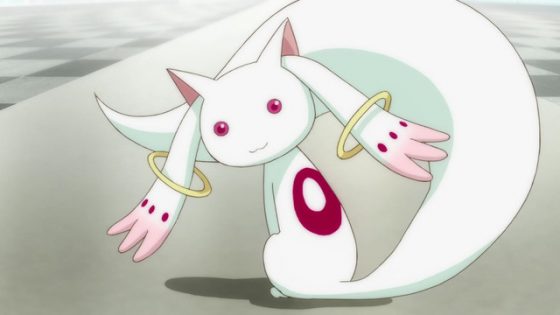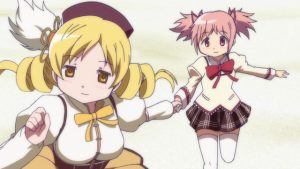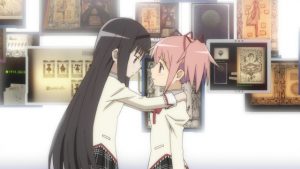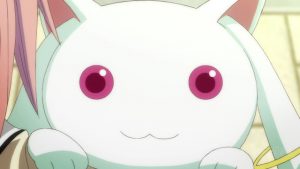
Within Madoka Magica, divisions are presented through lighting, architecture, and objects. Visually, these split the world in two, creating a distinct before and after--a character’s childhood and their adulthood.
By borrowing from its predecessors, Madoka Magica reveals the importance of the mascot/mentor figure. Their influence imparts values necessary for kids to have a hopeful future. However, by denying the cast its role models, Madoka Magica takes the anxiety of adolescence and manifests it outwards.
In this article, we will discuss Kyubey’s role as a “mentor” and how his influence impacts Homura’s worldview. Through her, we can transition to the topic of how time influences perception in film and Madoka Magica.
The Nurturing Growth: Understanding Egg Symbolism
Kyubey is unlike his mascot predecessors. Whenever a character accepts his contract, their soul is released in the form of a soul gem, an egg-shaped object.
Across cultures, the meaning of eggs can be shared or vary: rebirth (Christianity), wealth/gold (Alchemy), and the origin of life/creationism (Hinduism). However, there are universal meanings, two of which are promise (hope), and unhatched potential.
With this context, Kyubey’s title makes more sense. As an incubator, his goal is to take that “unhatched potential” and harvest it. Whereas mascot/mentor characters want to nurture their students’ growth--to become more than just an egg-- Kyubey stunts his “disciples.”
In the series, it’s implied that once the soul leaves the body, the body can no longer grow. All that potential is gone and with that hope. His “students" become “shells without the yolk.” It is no surprise then that his “students” embody not hope, but hopelessness.
The Importance of Magical Girl Stories
Magical Girl stories have a purpose: to educate and teach values to its audience. Like the mentors in their shows, these stories inspire a generation of kids, the target demographic. As the characters are taught lessons, the audience is as well.
As the main character develops, their growth parallels the audience’s growth, their transition into adulthood. The main character becomes a role model, a teacher themselves. They teach optimism through their actions--that the future doesn’t need to be uncertain or scary. It can be filled with hope.
At first, magic seems removed from reality, but these shows want to prove its existence; that it’s not fantasy but reality. Magic is not the ability to cast spells or to fly. It’s not even what makes a girl change into another form. True magic comes from a source. It is a power fueled from within: our emotions and our bonds--that is truly magic.
However, none of those lessons were taught to Homura. Her childhood shattered before she could believe in them. What took 3 episodes for others to learn took 20 minutes for Homura; the world was always uncaring. It never held “magic.” Just the empty shell of it.
Embodying Hopelessness
Kyubey is a guide without “directions,” and while he isn’t the stereotypical mascot/mentor, he still teaches a cruel lesson. In the previous article, it was shown how Kyubey is emotionally and physically distant from humanity. His indifference is his greatest tool. If a student is a reflection of their teacher, then Kyubey’s student must embody his lessons.
Thus, Homura is the “student” who best reflects his “teachings.” She is the one who most comes into contact with him. She is the most distant from others-- separated quite literally by time and space. She is the one who discards her emotions. She is the one that embodies hopelessness.
In episode 10, aptly titled “I Won’t Rely on Anyone Anymore,” we learn how Homura is the second main character in the series. Episode 10 is the “thesis statement” of prior episodes, the culmination of the “lessons” taught thus far.
The worthlessness of human significance, the pain of keeping one’s emotions, the futility of hope, and the cruelty of the world--Homura has learned them all. If these lessons oppose magical girl values, then Homura is their antithesis.
To prove this, we will discuss some film concepts and transition to the next article for a better understanding.
Building Empathy Through Perception
Before we prove this, we should discuss some film concepts. Film is an influential medium, one where viewers can share a character’s feelings and experiences. To place the audience in a character’s mind takes a deliberate effort.
To achieve this, cameras can mirror a character’s movement. The camera occupies the same places as a character. It goes through the same gestures and motions. A camera can emulating a character’s physical energy, allowing an audience to walk the same journey. The camera can place you in a “character’s shoes.”
Once the audience has shared the experiences of the camera, the next step is to share a character’s emotions. To make the audience empathize with a character, they must occupy a shared space--what was once physical must become mental.
This means that a camera doesn’t just physically emulate a character, it can mentally emulate it as well. The camera is the lens through which we see their world. To prove this, time is necessary. It’s required to absorb details, to make meaning out of what’s on screen. If time is required to understand, then...
Time changes perception.
Final Thoughts

Time is an integral element. It can make a good joke hit its mark, allow people to find wisdom, and make ideas find their spark. For Madoka Magica, time is more than a source of magic, it’s a source of Homura’s perception. If time reveals all, then for Homura, time reveals hopelessness.
For the next article, I will discuss how Madoka Magica develops visual themes through episode 10, and the reasons for Homura’s rejection of magical girl values.




